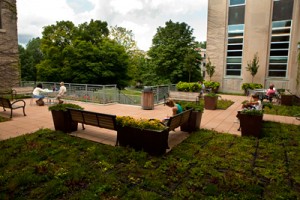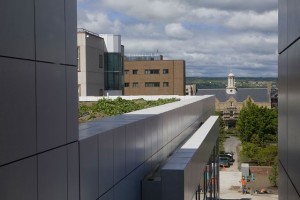Share This
Related Posts
Tags
Biophilic Design
By Erica Rascón on Aug 6, 2012 in News
 Will homes of the future have super powers sourced from nature?
Will homes of the future have super powers sourced from nature?
The concept of biophilia has intrigued architects since the 1970. Simply put, biophilic design is a building methodology that integrates natural elements into the building process, including construction materials, ventilation methods, lighting techniques, and more. The current popularity of green building practices has pulled the concept from the shadows, pushing it back into the limelight for further examination and use.
Our bodies respond on a cellular level to natural stimuli. In “Courting Nature in Design,” B.J. Novitski explains that humans “haven’t evolved away from a psychological dependence on the natural world, an affinity known as ‘biophilia.’” When architecture limits human access to the natural environment, our bodies suffer. Conversely, earth-conscious construction and healthy interiors promote physical and mental wellbeing in a manner that has become increasing quantifiable.
Benefits of Biophilic Design
What if multifamily firms could promote housing that noticeably improved residents’ health? Research into biophilia largely focuses on the mental and physical health benefits, though new research shows that there are social advantages as well.
National Renewable Energy Laboratory researched the benefits of natural light on building occupants. Findings include improved disposition, improved morale, and reduced levels of fatigue. Natural light exposure is also linked to reduced stress and anxiety levels.
Exposure to plant life holds health benefits as well. Marjolein Elings of the Wageningen University and Research Centre has published findings in Plant Research International that document health improvements in people with prolonged exposure to living plants. Health benefits included lower blood pressure, increased productivity in the workplace, reduced anxiety levels, and heightened alertness. Health benefits are more noticeable when people work with the plants, actively caring for and interacting with them.
In addition to nature’s benefits on the body, exposure to nature can improve human relations in multifamily settings. Implementing biophilic design promotes a safer living environment, which appeals to buyers across demographic groups. NYC planning firm Terrapin Bright Green has blazed the trail into the benefits of biophilic design in housing. Research published in “The Economics of Biophilia,” suggests that biophilic buildings can be a viable “cost-effective strategy to reduce the impact of our medical and social problems.” Studies conducted in urban public housing developments with green features and access to nature have shown a reduction of domestic violence and felony arrests of residents.
Though people are drawn to nature friendly housing on a visceral level, renters and office workers may not even be aware that they are responding to green stimuli. Positive response to such projects often happens in subconscious decision-making, making green features a subtle but significant influencer.
Financial Returns
 Residents are not the only ones who can reap the rewards of living in a natural environment. There can be positive financial returns for developers of biophilic projects. Terrapin’s research indicates that tenants are willing to pay for access to nature. For example, tenants place a price tag on good views: waterfront properties can increase rental rates by 59% and housing with water views can result in increases of 30%. Lush landscaping alone can contribute to 7% increase in rental rates and a 4-5% higher rate than housing with poor landscaping. Access to green space or a park within 500 feet of a property carries a 5% premium.
Residents are not the only ones who can reap the rewards of living in a natural environment. There can be positive financial returns for developers of biophilic projects. Terrapin’s research indicates that tenants are willing to pay for access to nature. For example, tenants place a price tag on good views: waterfront properties can increase rental rates by 59% and housing with water views can result in increases of 30%. Lush landscaping alone can contribute to 7% increase in rental rates and a 4-5% higher rate than housing with poor landscaping. Access to green space or a park within 500 feet of a property carries a 5% premium.
Biophilic design encourages the use of locally sourced eco-materials, and buildings that fit into the natural terrain. Common attributes:
- Access to plant life indoors and outdoors, ample natural light, and the presence of organic forms
- Sustainably-sourced materials
- Visual diversity (nature views)
- Improved air quality through natural, energy-efficient ventilation
- Universal accessibility for users of all ability levels
Currently, there is not a LEED equivalent to biophilic building. There exists no compilation of standards in which designers should aspire (though many sustainable building practices steer firms towards the goals of biophilic design). Without such standards, there are limitless possibilities to approaching biophilic building project.
Green roofing is a popular project that is used throughout the nation with multiple benefits for firms and tenants. A green roof limits ambient heat build-up and minimizes storm water runoff. The roof doubles as an urban garden, potentially with excellent nature views. Both selling points increase the value of the rental property.
Five residence halls at Cornell University were equipped with vegetated roofs. Native plants blend the created environment with its natural counterpart, drawing local birds and butterflies to the property. The roofs of pavilions scattered throughout the residence halls permit daylight to enter the interior corridors with minimal heat transfer. Additionally, the buildings are aligned east to west, mimicking the surrounding terrain and promoting optimal use of daylight.
Residents in these halls are perpetually surrounded by the positive influences of nature with effortless access to daylight, foliage, local wildlife, and an alignment with their environment. These benefits came at virtually no additional costs—the costs of the Cornell’s residence halls compare with the costs of similar, though less green, projects in the area—yet the institution’s marketing team can use the halls as real examples of improved livelihood on campus.
Multifamily housing for residents of all ages can benefit from the implementation of biophilic concepts. As research in the field continues to unfold, firms can tap into the economic value of natural spaces as well as the social and health benefits delivered to residents through those spaces. Housing that appeals to tenants’ mental, physical, and social wellbeing are the future, outshining basic shelters with limitless potential.
